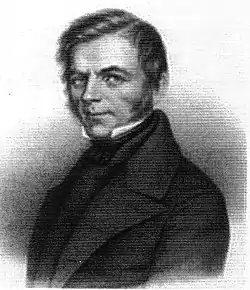Anders Sjögren | |
|---|---|
 | |
| Born | Andreas Johan Sjögren 8 May 1794 |
| Died | 18 January 1855 (aged 60) |
| Known for | Researcher of Finno-Ugric and Samoyedic languages |
| Scientific career | |
| Institutions | Royal Academy of Åbo |
Anders Johan Sjögren (also spelled Andreas Johan Sjögren, in Russian also known as Andrei Mikhailovich Shëgren, Андре́й Миха́йлович Шёгрен; May 8, 1794 in Iitti, Finland – January 18, 1855 in St. Petersburg, Russia) was a Finnish linguist, ethnographer, historian and explorer. He is known especially for his work with various Finno-Ugric languages such as Veps. Sjögren is considered the creator of the Ossetian Cyrillic alphabet, which is still used today with some modifications.

Biography
Sjögren was the son of a shoemaker from the village of Sitikkala in the Iitti municipality in southeastern Finland, in those times (until 1809) part of Sweden but close to the Russian border.[1][2] With support from the local clergy, the gifted boy could learn Swedish (the language of the education system in Finland at those times) and go to school in Loviisa and Porvoo, then to university in Turku, where he graduated in 1819. During his studies he was inspired by Herderian Romantic Nationalism and started collecting Finnish folk poetry.[3]
In 1819, Sjögren moved to St. Petersburg, aspiring to a scholarship for conducting research with the Finno-Ugric languages and peoples of Russia. After receiving this grant, he traveled in Northern Russia from 1824 to 1829, From Eastern Finland and Karelia, he traveled eastwards to the Urals, then south to the Volga region, and returned to St. Petersburg with a wealth of data from diverse languages and cultures. He received a position at the Russian Academy of Sciences and published the results of his fieldwork in the years 1830–1834. These included new insights into the relatedness of the Finno-Ugric languages, a pioneering description of Veps, and a description of the Komi language.[3]
In 1835–1852, he traveled around the Caucasus, exploring the languages and ethnography of the Ossetians, Georgians and some other Caucasian peoples. In 1846–1852, he collected field materials in Livland and Courland for the Russian Geographical Society.[4] He created a grammar and dictionary of the Liv language, which were published after his death by Ferdinand Wiedemann, as well as the first "Ossetian Grammar" (Grammatik der ossetischen Sprache).[5] He was elected to the Russian Academy of Sciences and through the Academy provided sponsorship and research funding to Matthias Castrén, another ethnologist and philologist in the study of Uralic languages.[1]
References
- 1 2 Pelto, Pertti J. (2017-03-03). Mixed Methods in Ethnographic Research: Historical Perspectives. Taylor & Francis. p. 20. ISBN 978-1-351-85729-1.
- ↑ Friedrich, Doris; Hirnsperger, Markus; Bauer, Stefan (2022-07-07). More than 'Nature': Research on Infrastructure and Settlements in the North. LIT Verlag Münster. p. 11. ISBN 978-3-643-91218-3.
- 1 2 Branch, Michael (2002-06-14). "Sjögren, Anders Johan (1794–1855)". Kansallisbiografia. Retrieved 2023-09-11.
- ↑ Tyack, Geoffrey (2022-03-02). The Making of Our Urban Landscape. Oxford University Press. p. 72. ISBN 978-0-19-251123-2.
- ↑ Прохоров, А. М., ed. (1978). "Шегрен Андрей Михайлович". «Большая Советская Энциклопедия” (В 30 томах). Vol. 29. Москва: Советская энциклопедия. pp. 363–364.
Literature
- Branch, Michael (1973). A. J. Sjögren: Studies of the North. Helsinki: Finno-Ugrian Society.